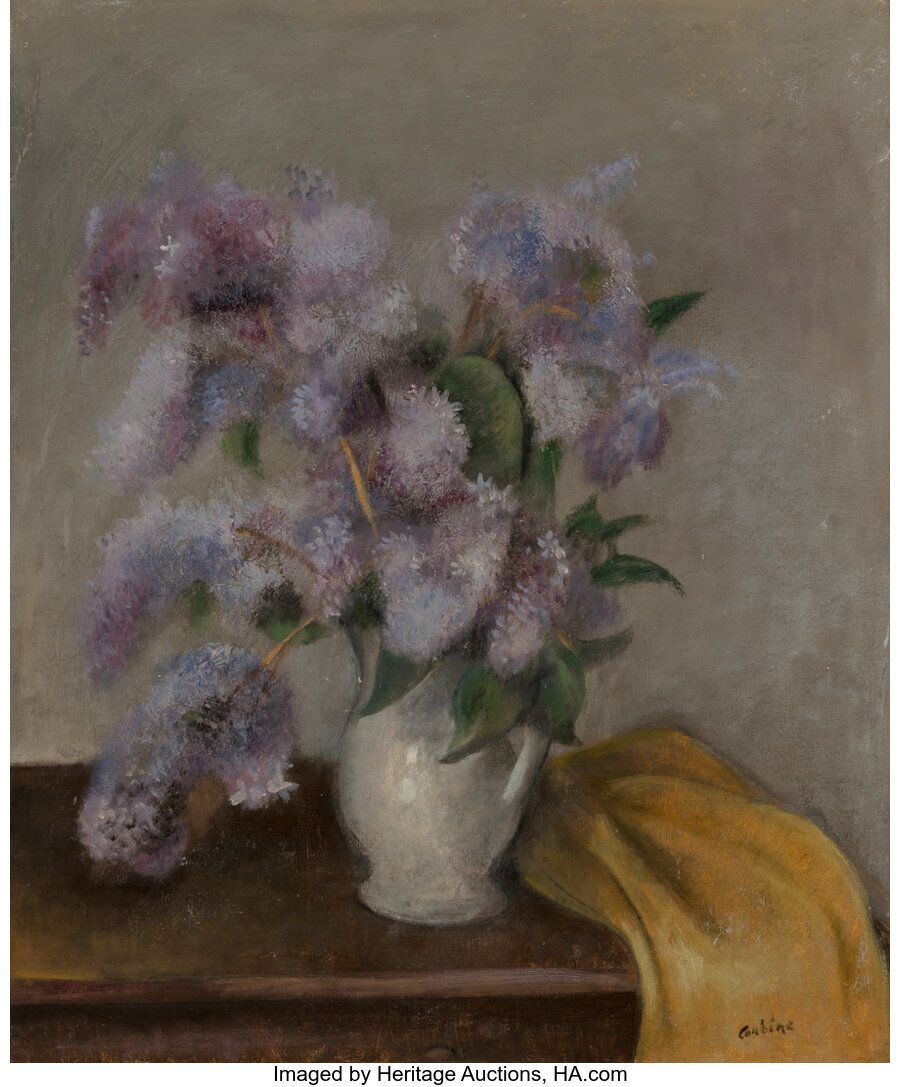Description
Othon Coubine (Czech, 1883-1969) Bouquet of lilacs in a vase, 1929 Oil on canvas 25-3/4 x 21-1/2 inches (65.4 x 54.6 ...
Othon Coubine (Czech, 1883-1969) Bouquet of lilacs in a vase, 1929 Oil on canvas 25-3/4 x 21-1/2 inches (65.4 x 54.6 cm) Signed lower right: Coubine PROVENANCE: Galerie Théophile Bríant, Paris; Private collection, Switzerland; Max Müller, Switzerland, acquired from the above, 1930s; Thence by descent to the present owner, 1973. We are grateful to Dr. Rea Michalová, art historian/curator and specialist on the art of Othon Coubine, for his enthusiastic endorsement of the present work and for preparing this thoughtful catalogue essay. Bouquet of lilacs in a vase is an outstanding example of the floral still lifes painted during the 1920s by Otakar Kubín (known in France as Othon Coubine), the most famous and consistent representative of Czech neoclassicism, an art movement known in France as the "retour à l'ordre". The painter's distinctive, lyrical conception of the motif is characterized by a shimmering sense of atmosphere and near-color harmonies that impart a strong emotional vibration to his work. Coubine's attachment to the neo-realist current reflected his personal sensibilities, his response to the post-war atmosphere, and his particular inspiration from the work of French artists Ingres and Corot—all of which combined to earn him considerable fame in France, where he lived permanently from 1912. The abundance of articles and publications written about his work by French and German art historians and critics not long after his arrival in France was a testament to his rapidly growing reputation. The first monograph on Coubine was published in 1922 by the editors of the Italian magazine "Valori plastici" (Plastic Values), which grouped him together with such luminaries as Carlo Carrà, Giorgio Morandi, Arturo Martini, and Gino Severini. Written by Maurice Raynal, a French theorist associated with a group of artists around Galerie de l'Effort Moderne's Léonce Rosenberg, one of the most influential art dealers of the twentieth century, the monograph laid out the philosophy of this group which sought to create a modern, new classicism. Coubine was thus situated directly in the center of this new European movement. The declaration of war [in 1914] dealt a dramatic blow to the artist. He was sent to an internment camp in Bordeaux and, after his release, material misery deprived him of the opportunity to paint in oil. He thus devoted himself during this period to the study of theoretical and philosophical writings at the Bibliothèque Nationale in Paris. In Blaise Pascal's treatise L'Esprit du géometrie ("Spirit of Geometry"), he discovered a justification for his new artistic inclinations. He frequented the Louvre, where he admired the Italian masters of the Quattrocento. It is in his drawings that his transition to classicism is reflected for the first time. The present painting, Bouquet of lilacs in a vase, shows Coubine, in a quest for ideal beauty, "adjusting" nature into configurations that do not naturally occur in it. On a wooden chest of drawers, he placed a simple, undecorated gray-white vase crowned with an expansive arrangement of a beautiful single-species bouquet of lilacs, plants of the olive family, which growing naturally both in France and abundantly in the Czech Republic. Their powerful perfume would doubtless have had an intensely sensory-emotional significance for the artist. Coubine was repeatedly inspired by the enchanting lilacs. For example, the National Gallery, Prague owns Coubine's Bouquet in a vase of 1924, in which the lilacs form a part of a multi-species bouquet; the Moravian Gallery in Brno owns a Bouquet of lilacs which is supplemented by a marigold, the bridal veil and iris. Against a neutral, silvery-gray background (a color tone inspired by the work of Corot), Coubine centrally placed a charming symphony of pastel-purple tones, conjuring the lilac blossoms with an impressionist "staccato," in contrast to the bottle-green heart-shaped leaves. Not only the bouquet itself, but especially the motif of the yellow drapery, which nonchalantly covers the right part of the chest of drawers, expresses the painter's fascination with the "uncanny" in everyday life that permanently surrounds us. HID12701242017
69006
Othon Coubine (Czech, 1883-1969) Bouquet of lilacs in a vase, 1929 Oil on canvas 25-3/4 x 21-1/2 inches (65.4 x 54.6 ...
